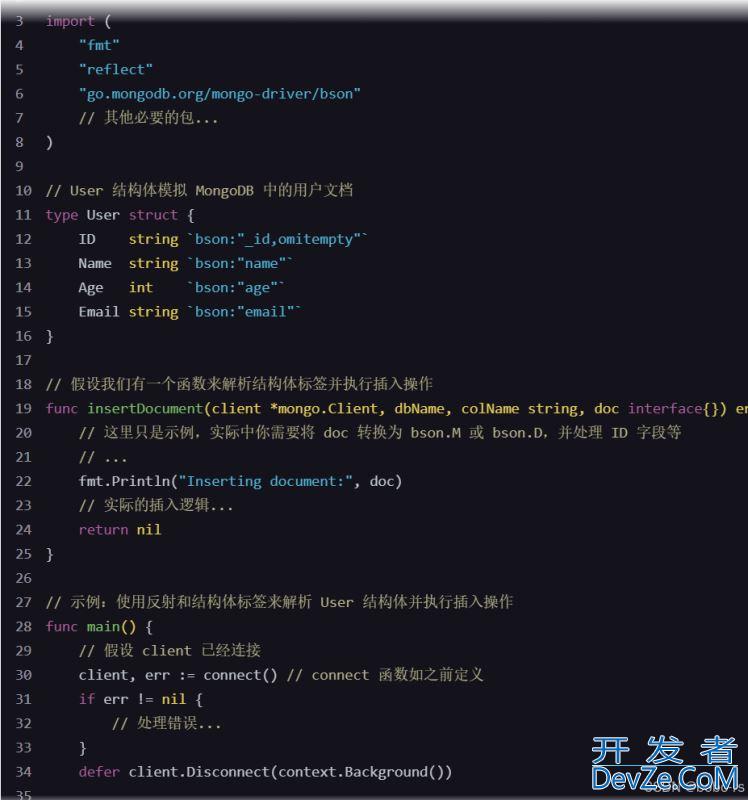Go使用MongoDB的操作指南(增删改查)
目录
- Go使用MongoDB应用指南
- 安装 MongoDB
- 安装 Go MongoDB 驱动
- 连接 MongoDB
- CRUD 操作示例
- 插入文档(Create)
- 查询文档(Read)
- 更新文档(Update)
- 删除文档(Delete)
- 1. 聚合管道
- 2. 事务
- 3. 地理空间查询
- 4. 索引管理
- 注意事项
- 总结
Go使用MongoDB应用指南
MongoDB 是一种高性能、开源、文档型的 NoSQL 数据库,广泛应用于 Web 应用、大数据以及云计算领域。Go 语言则以其快速、开发效率高、代码可维护性强著称。本指南将详细介绍如何在 Go 语言中使用 MongoDB 进行数据库操作,包括连接数据库、增删改查(CRUD)操作等。

安装 MongoDB
在开始之前,请确保已经安装了 MongoDB。安装方法根据操作系统而异:
- linux:可以使用包管理器如 apt-get 或 yum 进行安装。例如,在 Ubuntu 上可以使用以下命令:
sudo apt-get update sudo apt-get install mongodb sudo systemctl start mongodb
- Windows:可以从 MongoDB 官网下载对应版本的安装包,并按照提示进行安装。
安装 Go MongoDB 驱动
在 Go 中使用 MongoDB 需要安装相应的驱动。目前,推荐使用官方的 MongoDB Go 驱动:
go get go.mongodb.org/mongo-driver/mongo
连接 MongoDB
首先,我们需要编写一个函数来连接 MongoDB 并返回一个客户端实例:
package main
import (
"context"
"fmt"
"go.mongodb.org/mongo-driver/mongo"
"go.mongodb.org/mongo-driver/mongo/options"
"log"
"time"
)
func connect() (*mongo.Client, error) {
clientOptions := options.Client().ApplyURI("mongodb://localhost:27017")
client, err := mongo.Connect(context.TODO(), clientOptions)
if err != nil {
return nil, err
}
// 等待连接成功
err = client.Ping(context.Background(), nil)
if err != nil {
return nil, err
}
fmt.Println("Connected to MongoDB!")
return client, nil
}
CRUD 操作示例
插入文档(Create)
func insertDocument(client *mongo.Client, dbName, colName string, doc interface{}) error {
collection := client.Database(dbName).Collection(colName)
_, err := collection.InsertOne(context.Background(), doc)
return err
}
// 示例调用
func main() {
client, err := connect()
if err != nil {
log.Fatal(err)
}
defer client.Disconnect(context.Background())
doc := bson.M{"name": "Alice", "age": 28, "email": "alice@example.com"}
err = insertDocument(client, "testdb", "users", doc)
if err != nil {
log.Fatal(err)
}
fmt.Println("插入文档成功")
}
查询文档(Read)
func findDocuments(client *mongo.Client, dbName, colName string, filter bson.M) ([]bson.M, error) {
collection := client.Database(dbName).Collection(colName)
cur, err := collection.Find(context.Background(), filter)
if err != nil {
return nil, err
}
defer cur.Close(context.Background())
var results []bson.M
for cur.Next(context.Background()) {
var result bson.M
err := cur.Decode(&result)
if err != nil {
return nil, err
}
results = append(results, result)
}
if err := cur.Err(); err != nil {
return nil, err
}
return results, nil
}
// 示例调用
// 假设在 main 函数中已连接数据库
filter := bson.M{"name编程": "Alice"}
docs, err := findDocuments(client, "testdb", "users", filter)
if err != nil {
log.Fatal(err)
}
fmt.Println("查询结果:", docs)
更新文档(Update)
func updateDocument(client *mongo.Client, dbName, colName string, filter, update bson.M) error {
collection := client.Database(dbName).Collection(colName)
_, err := collection.UpdateOne(context.Background(), filter, bson.M{"$set": update})
return err
}
// 示例调用
编程update := bson.M{"age": 30}
```go
err = updateDocument(client, "testdb", "users", bson.M{"name": "Alice"}, update)
if err != nil {
log.Fatal(err)
}
fmt.Println("更新文档成功")
删除文档(Delete)
func deleteDocument(client *mongo.Client, dbName, colName string, filter bson.M) error {
collection := client.Database(dbName).Collection(colName)
_, err := collection.DeleteOne(context.Background(), filter)
return err
}
// 示例调用
err = deleteDocument(client, "testdb", "users", bson.M{"name": "Alice"})
if err != nil {
log.Fatal(err)
}
fmt.Println("删除文档成功")
以上是Go操作MongoDB的基础示例,我们接下来看一下它的一些高级特性:
在Go中操作MongoDB时,利用MongoDB Go驱动(如go.mongodb.org/mongo-driver/mongo)可以访问MongoDB的许多高级特性。这些特性包括但不限于聚合管道、事务、地理空间查询、索引管理等。下面,我将概述一些在Go中使用MongoDB高级特性的方法。
1. 聚合管道
MongoDB的聚合管道是一种强大的数据处理工具,它允许你通过一系列阶段(stages)对集合中的文档进行转换和聚合。
在Go中,你可以使用mongo.Collection.Aggregate方法来执行聚合查询。
package main
import (
"context"
"fmt"
"go.mongodb.org/mongo-driver/bson"
"go.mongodb.org/mongo-driver/mongo"
"go.mongodb.org/mongo-driver/mongo/options"
)
func main() {
// 连接到MongoDB(略过连接细节)
client, err := mongo.Connect(context.TODO(), options.Client().ApplyURI("your-mongodb-uri"))
if err != nil {
panic(err)
}
defer client.Disconnect(context.TODO())
collection := client.Database("yourdb").Collection("yourcollection")
// 构建聚合管道
pipeline := mongo.Pipeline{
{{"$match", bson.D{{"status", "A"}}}},
{{"$group", bson.D{
{"_id", "$cust_id"},
{"total", bson.D{{"$sum", "$amount"}}},
}}},
}
// 执行聚合查询
cur, err := collection.Aggregate(context.TODO(), pipeline)
if err != nil {
panic(err)
}
defer cur.Close(context.TODO())
// 迭代结果
for cur.Next(context.TODO()) {
var result bson.M
err := cur.Decode(&result)
if err != nil {
panic(err)
}
fmt.Println(result)
}
if err := cur.Err(); err != nil {
panic(err)
}
}
2. 事务
MongoDB支持跨多个集合、数据库甚至分片集群的ACID事务。在Go中,你可以使用会话(sessions)来管理事务。
package main
import (
"context"
"fmt"
"go.mongodb.org/mongo-driver/bson"
"go.mongodb.org/mongo-driver/mongo"
"go.mongodb.org/mongo-driver/mongo/optionwww.devze.coms"
)
func main() {
// 连接到MongoDB(略过连接细节)
client, err := mongo.Connect(context.TODO(), options.Client().ApplyURI("your-mongodb-uri"))
if err != nil {
panic(err)
}
defer client.Disconnect(context.TODO())
// 创建一个会话
session, err := client.StartSession()
if err != nil {
panic(err)
}
defer session.EndSession(context.TODO())
// 在会话中设置事务选项
javascript session.StartTransaction(options.Transaction().
ReadConcern(readconcern.Snapshot()).
WriteConcern(writeconcern.New(writeconcern.WMajority())))
// 在此会话中执行多个操作...
// 提交事务
err = session.CommitTransaction(context.TODO())
if err != nil {
// 如果出现错误,可以调用session.AbortTransaction(context.TODO())来回滚事务
panic(err)
}
}
3. 地理空间查询
MongoDB支持地理空间索引和查询,允许你根据地理位置来搜索文档。
// 假设你有一个包含地理位置信息的文档集合
// ...
// 构建一个地理空间查询
query := bson.D{{
"$geoWithin", bson.D{{
"$centerSphere", bson.A{
[]float64{longitude, latitude}, // 中心点坐标
radius / earthRadius, // 半径(以弧度为单位),earthRadius是地球的平均半径(约6371公里)
},
}},
}}
// 使用查询...
4. 索引管理
MongoDB允许你创建和管理索引来优化查询性能,你可以通过MongoDB的Go驱动来创建、列出、删除和修改索引。
创建索引
使用mongo.Collection.Indexes().CreateOne方法可以在集合上创建一个新的索引。
package main
import (
"context"
"fmt"
"go.mongodb.org/mongo-driver/bson"
"go.mongodb.org/mongo-driver/mongo"
"go.mongodb.org/mongo-driver/mongo/options"
)
func main() {
// 连接到MongoDB(略过连接细节)
client, err := mongo.Connect(context.TODO(), options.Client().ApplyURI("your-mongodb-uri"))
if err != nil {
panic(err)
}
defer client.Disconnect(context.TODO())
collection := client.Database("yourdb").Collection("yourcollection")
// 创建一个索引,例如,对"username"字段进行升序索引
indexModel := mongo.IndexModel{
Keys: bson.D{{"username", 1}},
Options: options.Index().SetUnique(true), // 设置索引为唯一索引
}
// 创建索引
_, err = collection.Indexes().CreateOne(context.TODO(), indexModel)
if err != nil {
panic(err)
}
fmt.Println("Index created successfully")
}
列出索引
使用mongo.Collection.Indexes().List方法可以列出集合上的所有索引。
// ...(连接到MongoDB的代码略)
// 列出索引
cur, err := collection.Indexes().List(context.TODO())
if err != nil {
panic(err)
}
defer cur.Close(context.TODO())
for cur.Next(context.TODO()) {
var index bson.M
err := cur.Decode(&index)
if err != nil {
panic(err)
}
fmt.Println(index)
}
if err := cur.Err(); err != nil {
panic(err)
}
删除索引
使用mongo.Collection.Indexes().DropOne或mongo.Collection.Indexes().DropAll方法可以删除一个或所有索引。
// 删除单个索引
indexName := "username_1" // 索引的名称,通常是字段名加排序方向
err = collection.Indexes().DropOne(context.TODO(), indexName)
if err != nil {
panic(err)
}
// 或者,删除所有索引(除了_id索引)
// 注意:这通常不是一个好的做法,除非你有特别的理由
// err = collection.Indexes().DropAll(context.TODO())
// if err != nil {
// panic(err)
// }
注意事项
- 索引可以提高查询性能,但它们也会占用额外的磁盘空间,并可能降低插入、更新和删除操作的性能。因此,在设计索引时需要权衡这些因素。
- MongoDB会自动为
_id字段创建索引,并且这个索引是唯一的。 - 唯一索引可以确保集合中的每个文档在指定字段上都有一个唯一的值,这有助于避免数据重复。
- 在使用地理位置查询时,MongoDB支持多种地理空间索引类型,如2dsphere索引,用于存储地球表面的点、线和多边形。
以上就是在Go中管理MongoDB索引的基本方法。通过合理使用索引,你可以显著提高应用程序的性能和效率。
总结
在本指南中,我们详细介绍了如何在 Go 语言中使用 MongoDB 官方的 Go 驱动来执行基本的数据库操作,包括连接数据库、插入文档、查询文档、更新文档和删除文档。这些操作是构建任何基于 MongoDB 的应用的基础。
为了更高效地管理数据库连接,建议在应用启动时建立连接,并在应用关闭时断开连接。同时,对于频繁执php行的数据库操作,考虑使用连接池来优化性能。
此外,MongoDB 的查询和更新操作非常灵活,支持丰富的查询操作符和更新操作符,可以根据需要组合使用。不过,在编写查询和更新语句时,应注意性能问题,避免使用低效的查询条件或更新操作。
最后,MongoDB 的安全性也非常重要,建议设置访问控制、加密通信、定期备份等安全措施来保护数据库安全。在生产环境中,还应考虑使用 MongoDB Atlas 等云服务来简化部署和管理。
以上就是Go使用MongoDB的操作指南(增删改查)的详细内容,更多关于Go使用MongoDB的资料请关注编程客栈(www.devze.com)其它相关文章!






 加载中,请稍侯......
加载中,请稍侯......
精彩评论